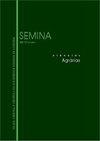男性生殖系统近期和慢性小反刍动物慢病毒感染的免疫反应动力学
IF 0.5
4区 农林科学
Q4 AGRICULTURE, MULTIDISCIPLINARY
引用次数: 1
摘要
本研究的目的是分析雄鹿对小反刍动物慢病毒(SRLV)的免疫反应,重点研究了近期和慢性感染雄鹿的生殖系统。共选取12只雄鹿,血清阴性6只,血清阳性6只,慢性自然感染18个月以上(慢性感染组)。选择动物后,6只血清阴性雄鼠静脉注射滴度为10-5,6 TCID50/mL的CAEV -Co病毒株。接种病毒后,将该组称为新近感染组,每周与慢性感染组监测180天,进行血清和精浆Western Blot (WB)分析。在慢性SRLV感染动物中,18.94%(50/264)至少在一份样本中显示出抗SRLV抗体,81.06%(214/264)呈阴性。本组血清样本中有27.27%(36/132)检测到抗srlv抗体,10.60%(14/132)的精浆WB检测有反应。接种CAEV-Co的动物在病毒接种第3周后血清呈阳性。在本组中,31.06%(41/132)的精浆样本含有抗srlv抗体,其中70.73%(29/41)的精浆样本与血清结果吻合。在剩余的29.27%(12/41)中,只有3只动物(RIA2、RIA3和RIA5)的精浆样本含有抗srlv抗体。其中一只最近感染的动物仅在精浆样本中出现抗srlv抗体,可能是由于病毒区隔化。无论感染阶段如何,在两种生物样本中均观察到间歇性病毒脱落。最近感染SRLV的雄鹿的免疫反应比长期感染的雄鹿更显著。无论感染的哪个阶段,抗体水平都有波动,因此,在进行诊断时,这会产生假阴性样本的风险。本文章由计算机程序翻译,如有差异,请以英文原文为准。
Immune response dynamics of recent and chronic small ruminant lentivirus infection in the male reproductive system
The objective of this study was to analyze the immune responses of bucks to small ruminant lentivirus (SRLV) with a focus on the reproductive system of males with recent and chronic infection. A total of 12 bucks were selected, six seronegative and six seropositive with chronic natural infection for more than 18 months (chronic infection group). After selecting the animals, the six seronegative males were intravenously inoculated with caprine arthritis-encephalitis virus (CAEV)-Co viral strain at a titer of 10-5,6 TCID50/mL. After viral inoculation, this group was called the recent infection group and was monitored weekly with the chronically infected group for 180 days with blood serum and seminal plasma Western Blot (WB) analysis. Of the animals with chronic SRLV infection, 18.94% (50/264) showed anti-SRLV antibodies in at least one of the samples, and 81.06% (214/264) were negative. Anti-SRLV antibodies were detected in 27.27% (36/132) of the blood serum samples from this group, while 10.60% (14/132) were reactive in the seminal plasma WB test. The animals inoculated with CAEV-Co became seropositive after the third week of viral inoculation. In this group, 31.06% (41/132) of seminal plasma samples had anti-SRLV antibodies, and of these, 70.73% (29/41) coincided with blood serum results. Of the remaining 29.27% (12/41), the seminal plasma sample of only three animals (RIA2, RIA3, and RIA5) had anti-SRLV antibodies. One of the animals with a recent infection presented anti-SRLV antibodies only in seminal plasma samples, possibly due to virus compartmentalization. Intermittent viral shedding was observed in both biological samples, regardless of the infection stage. The immune response in bucks with recent SRLV infection is more significant than in chronically infected animals. Regardless of the stage of infection, there is a fluctuation in antibody levels, therefore, this creates a risk of false-negative samples when performing the diagnosis.
求助全文
通过发布文献求助,成功后即可免费获取论文全文。
去求助
来源期刊

Semina-ciencias Agrarias
农林科学-农业综合
CiteScore
1.10
自引率
0.00%
发文量
148
审稿时长
3-6 weeks
期刊介绍:
The Journal Semina Ciencias Agrarias (Semina: Cien. Agrar.) is a quarterly publication promoting Science and Technology and is associated with the State University of Londrina. It publishes original and review articles, as well as case reports and communications in the field of Agricultural Sciences, Animal Sciences, Food Sciences and Veterinary Medicine.
 求助内容:
求助内容: 应助结果提醒方式:
应助结果提醒方式:


